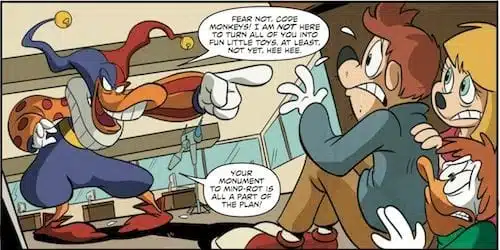
Previous PopMatters reviews of BOOM! Studios’ output of comic books based on licensed Disney properties have exposed the clever cultural critiques that frequently lurk under the glossy, family-friendly adventures on the surface. The two stories contained in this Darkwing Duck Annual are no different; indeed, the nakedly Batman-inspired Darkwing and the city of St. Canard, the Gotham stand-in he inhabits, are perhaps among the best tools the publisher’s writers and artists have at their disposal when it comes to slipping their cultural observations into the fun.
Behind the best of the book’s two alternate covers – a homage to Brian Bolland’s cover to Batman: The Killing Joke, featuring Darkwing’s foe Quackerjack wielding a camera – begins “Toy With Me”. Written by the book’s longtime scribe Ian Brill and crisply illustrated by Sabrina Alberghetti, this longer of the two stories is not only an entertaining clash between hero and villain but also a playful look at how videogames – in particular World of Warcraft – have begun to change the world.
Deranged toy-maker Quackerjack has decided that Whiffle Boy Entertainment’s ‘World of Whifflecraft’, the massively multiplayer game with a twelve million-strong playerbase, is a “monument to mind-rot”. Old-fashioned toys are so much better, the villain concludes, that he will use a techno-magical laser beam to convert the game’s makers, and then its players, into human playthings. To illustrate Quackerjack’s point, a gamer is shown in a run-down apartment on a torn sofa laden with spilt drinks, his eyes drooping. If the stereotype seems a little crass, we’re quickly reminded that this is the view of the villain of the piece, not its creators. Later, when Darkwing deftly defeats his foe by taking control of the laser, he credits a videogame with giving him the hand-eye co-ordination he needed to succeed; seen in the context of a comic book, this gesture is like a conciliatory pat on the back from one much-maligned media to another.
Brill’s script has still more to offer, focused on a surprisingly deep look at the tale’s antagonist; a set of flashbacks intriguingly trace Quackerjack’s origin as a villain to his mistreatment by an unimaginative corporate culture, illustrated by his isolation in an office cubicle, his male and female colleagues separated by sex and laughing on either side of him. Back in the present, Jacky’s last act after he evades capture by Darkwing is a powerfully poignant one which really dodged this reader’s expectations and brings the story to a great conclusion.
The second story, “The Untimely Terror of the Time Turtle”, is in some ways more slight than its longer predecessor but takes some admirable narrative risks. With a carefully crafted script by Darkwing Duck‘s creator Tad Stones and art by James Silvani, the tale uses the time-travelling powers bestowed upon the villain Chronoduck by a turtle “slow enough to crawl between seconds and into the chronoplasm of time” to play some intelligent and time-bending tricks on not just the characters, but the reader, too. Indeed, the ploy is so well-judged that re-reading the story to really grasp it is a pleasure, rather than the chore it might have been in less capable hands. Light-heartedly grappling with temporal paradoxes more expected of a Terminator film, this Darkwing Duck outing has something to offer for kids and adults alike.
Naturally this is not to say that older comics readers without kids should or would go rushing out to buy this book, but for those with a “way in” to Darkwing Duck the annual has one last trick up its sleeve. For a few pages, Tad Stones is given the chance to write about his character’s origins, explaining how James Bond trademark issues nixed the original concept of “Double-O Duck” and necessitated a new name, and how Darkwing has Judge Dredd to thank for the inspiration behind his duck-themed motorcycle transport. All this background material sets Darkwing Duck into a much wider cultural context than might otherwise have been expected, pointing out the character is “largely the product of the Silver Age of Comics”. Darkwing’s origins may be disparate – reflecting the Joker’s comment in The Killing Joke that “if I’m going to have a past, I prefer it to be multiple choice!” – but on the evidence of this annual, the character deserves to have a future yet.
